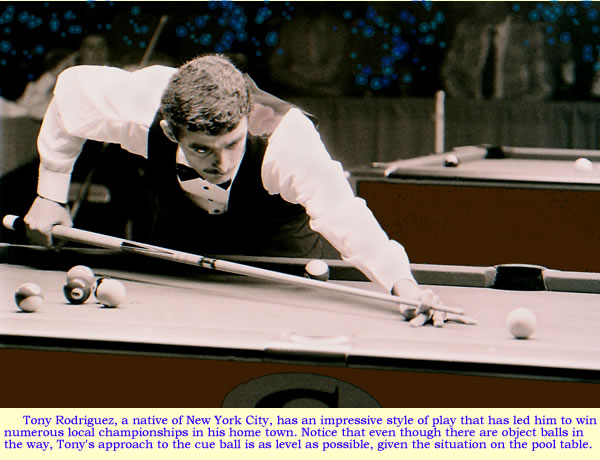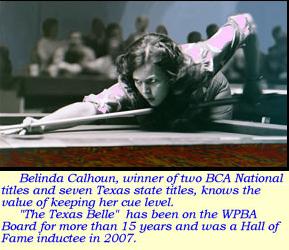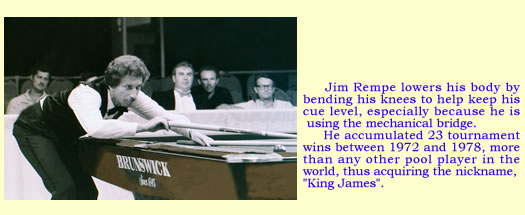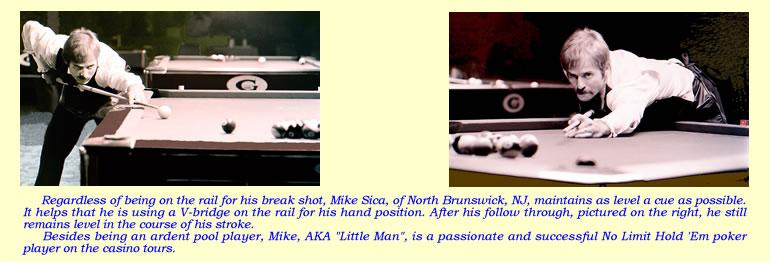.....When
I was learning how to play pool there were no books, no videos,
no instructors and no leagues to play in. The best way to learn
was to watch. I was privileged to see some of the greatest and
some of the not so great. My purpose for publishing my pointers
insrtuctional column is not only to inpart pool knowledge to my
viewers but to share with the public what these great players from
the 1980s and 1990s looked like. Through my trusty Canon, for a
moment in time they are immortalized. Some are still here and some
are gone and I still remember the joy of watching them play.

.
STAYING LEVEL HEADED AND LEVEL CUED WINS THE
MATCH
Keep a level cue

…..THE MOST IMPORTANT REASON for keeping your cue stick
level is to cultivate more powerful positioning techniques. And
maintaining a level cue stick when shooting pool does avoid some
of the problems associated with hitting the cue ball incorrectly,
such as bouncing the cue ball, unwanted english, and miscues.
…..If you are a beginner or
intermediate, you may be struggling with keeping the cue level
as you stroke the cue ball. Nevertheless it’s a barrier that
you must over come in order to improve your game.
…..A key element is learning how to raise and lower both
your open and closed hand bridges. I discuss how to formulate those
bridges in other columns nevertheless here are a few tips. A mistake
lots of players make is leaning or tilting up the thumb side of
their hand bridge. Doing that tips up the back of the cue stick
and stops one from raising or lowering your bridge fingers. Take
a close look at the hand bridges of Tony and Belinda and see how
flat the heel of their hand is on the table. Keeping the heel of
your hand flat allows you to raise or lower your fingers by raising
or lowering the “tent” shape part of your hand bridge.
This allows the front end of your cue to go up or down the vertical
axis of the cue ball without having to raise up the butt of your
cue stick.
…..If you think of your bridge hand as a fulcrum, which
is the part that supplies capability for action of the lever (your
cue stick), you can imagine that moving your hand closer or further
away from the cue ball in itself allows you to manipulate the vertical
axis. Changing the distance your hand is away from your cue ball
is an alternate way of going up and down the cue ball while staying
level. If you come closer your tip is above center and if you drop
your hand further back you approach the bottom of the cue ball.
 …..Do
not lift up on the cue stick when you pull back. A piece of advice
that will help concerns placement of your backhand on the cue.
When the stick is at rest, place your back hand at your hip as
pictured by Johnny Archer at the US Open. Johnny is at the starting
point of his swing and his backhand is right at his hip. If you
put the back hand past your hip, on your back swing you have
no where to go but up. That’s what causes
the up and down motion prevalent in the .swing
of beginner and intermediate players. …..Do
not lift up on the cue stick when you pull back. A piece of advice
that will help concerns placement of your backhand on the cue.
When the stick is at rest, place your back hand at your hip as
pictured by Johnny Archer at the US Open. Johnny is at the starting
point of his swing and his backhand is right at his hip. If you
put the back hand past your hip, on your back swing you have
no where to go but up. That’s what causes
the up and down motion prevalent in the .swing
of beginner and intermediate players.

…..And
even after you contact the cue ball, you must maintain that level
approach during your follow through. Don’t shoot
down into the table. Yes, if you follow through long enough you
start to go down but you should maintain your approach to the cue
ball at least through the width of it. Pictured below is Mike Sica
before and after his follow through. You can see that
even after the cue ball is gone his stick is still at the height
of center ball.
…..You always want to have your cue as parallel to the
table as you could possibly keep it. Though granted, there are
times that this is not going to be possible because there are other
balls in the way or because you are close to the rail. Observe
in the photograph above how level Tony Rodriguez is able to stay
even with some object balls in his way.

…..Look around
your pool room some time and you’ll
no doubt observe that the back of almost everybody’s cue
is elevated, especially when the cue ball is near the rail. Only
the more advanced, seasoned players will be level. The only reason
I can think of for that is that it just plain feels good.
Trying to keep the back of your cue down is an effort but stick
with it if you want to improve your game.


.....Pool Pointer Archives
.....1. Closed Half-Bridge
... .2.
Look Before You Leap
.....3. Mechanically Inclined
.....4. Keep a Level Cue
.....Tune in for more Pointer articles
coming your way each month.

|

